Lifevests and Buoyancy Aids
A personal flotation device (also named PFD, life jacket, life preserver, lifevest, life saver, cork jacket, life belt, or buoyancy aid) is a device designed to keep a wearer afloat and their head above water.
The terms "lifevest" or "lifejacket" can include all types of such devices from life preservers to life jackets to survival suits. They are available in different sizes and different designs purposed for various levels of protection.
Lifejacket or Buoyancy Aid?
Whenever possible choose lifevests instead of buoyancy aids. They can turn unconscious people on their back, allowing them to breathe. Buoyancy aids don't.
A proper lifevest will turn you from a face down position onto your back, so you can breathe.
Anything else is no lifevest, just an "insurance cover".
Swimming Practice
Practice swimming in different lifevests before any adventures. Wear them over all your boating clothes and jump into the water. See how they float you up, and how well they fit with all your clothes. If a lifevest is not comfortable you probably won't wear it for long.

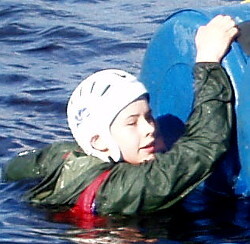
Lifevest Types
Type I - Off-Shore Lifevest
Bulky, but floats you best. Best flotation for open, rough or remote waters. Turns most unconscious wearers face-up in the water. A Type I PFD provides more buoyancy than any other type and turn most unconscious wearers into a face-up position with their head out of the water.
This type requires a minimum adult buoyancy of 10 kg.
Because of its bulk it is generally not comfortable to wear when not on the water.
They are typically jacket-shaped but sleeveless, and usually have multiple ties and belts for closure.
Type II - Near-Shore Buoyancy Vest
Familiar to anyone who has rented a canoe or other pleasure craft, these are the bright orange vests also seen on water taxis and the like.
They are a reduced version of the Type I PFD, and provide a minimum 7 kg buoyancy. Most have just one belt tie.
Type II PFDs are used near shore where a quick rescue is possible, like in water sports centres.
They will usually turn the face of an unconscious person out of the water,
but are not as dependable as Type I PFDs for this task.
Type III - Flotation Buoyancy Aid
Buoyancy aids are useful for immersion sports where you often go into deep water. They are intended for use by competent swimmers who are near to the shore, or who have help and a means of rescue close at hand. Most popular with canoeists, kayakers and small sailboat racers, they are best for conscious wearers who can keep their own faces out of the water.
Type III PFDs are usually jacket-style and may have pockets, lashing hooks, tow belts, and other functions that enhance their application. They typically fit the wearer closely, and many have buckles or zips to close.
They have minimal bulk and are of limited use in disturbed water as they cannot be expected to keep you safe for a long period of time. The minimum buoyancy is 7 kg, but the better designs have higher buoyancy (frequently 8 kg).
Designed to keep you afloat, they allow you full movement during your water sports,
when you are in a sailing dinghy, personal watercraft, windsurfer, canoe or water-skiing
or if providing safety cover for such an activity.
Buoyancy aids assist deep water activities including entries and treading water.
WARNING:
Buoyancy aids will not turn you on your back if you're unconscious, but let you float face down. Hence they are known as "Insurance Covers" because they fulfil insurance requirements, but not much else.
A common sight around leisure centres are buoyancy aids that are worn in the wrong size. They reach over the ears and are way too large. This is a hazard as it can lead to breathing difficulties and injuries.
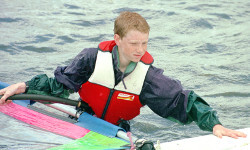
This bouyancy aid fits well.

This bouyancy aid could kill him.
Special Purpose
Approved for the activities listed on the label. Some are approved for white water rafting, board sailing, etc. This type also includes new hybrid PFDs with foam floatation and an inflatable chamber. Type V Hybrid PFDs are as comfortable to wear as a Type III but when fully inflated have the floatation performance of a Type II or better.
Their turning performance (keeping an unconscious person face-up) is rated according to PFD types I, II, and III.
Type V PFDs come in a variety of styles, from full-body suits to work vests.
Some have a safety harness and some provide protection against hypothermia (survival suits).
Floating Jacket
It looks like an elegant splash top, but has a buoyancy aid or lifevest build in. Kick the inconvenience of changing in and out of your PFD as you go on and off boats, with the PFD integrated directly into an elements-blocking jacket.
Designed to deliver comfort, warmth, and durability during watersports or lifeguard patrol, it uses closed-cell foam for flotation and in-water insulation to avoid the onset of hypothermia during immersion. This is useful for watersports where you occasionally go into the water and where additional floatation and warmth is a concern. It can be given to a casualty as floating aid.
You barely notice the added buoyancy layers. It just feels like a padded jacket. But when you go into the water you quickly realise a helpful lift. Swimming is relatively easy compared to the alternatives. The sealed foam cells don't absorb water. The rest of the jacket is just nylon, so it drains quickly. We've found it very comfortable on land, in boats, and in the water.
Some floating jackets have leg straps to keep them from riding up.
There are also fleece-lined pockets and compartments in which to keep signaling devices
or a VHF radio and other survival items.
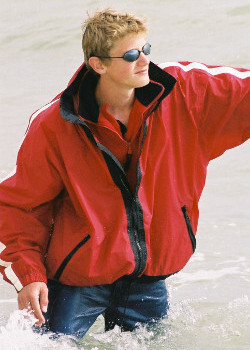
Looks like any sailing jacket.
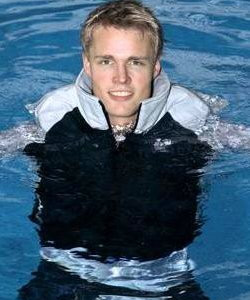
When you go into the water during your aquatic sports you quickly realise a helpful lift.
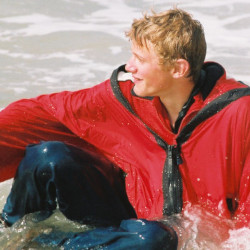
We've found the floating jacket very comfortable on land, in boats, and in the water. Swimming is relatively easy compared to the alternatives.
Lifevest Training Lesson Plan
Lifevests and other Equipment
Take a good look at the different personal floatation devices (PFD).
Show the difference between buoyancy aids and lifevests.
Let everyone try them on.
Check it out before you jump in
Is it a lifevest that can save your life, or just a buoyancy aid?
Make sure it is the right size for you.
A wrong size can hurt you.
Use a Lifevest or Bouyancy Aid
Give your class a chance to try out the different floatation devices in the water.
Swim two lengths with each device.
Avoid chafing on bare skin with soft clothes.
Warm-up Game
This exercise simulates a rescue situation where lifevests are thrown out to people in the water.
Throw enough lifevests for everyone into the middle of the pool.
Then get your team to jump in, swim out and put on the lifevests in the water.
This can be quite a challenge, especially when you are fully clothed.
Practice Lifevest Handling
Practice wearing a life jacket, enter the water using ladder, steps or side.
Later on jump into the water, holding the lifevest close to the chest to keep it from hitting your face.
Floating
Float for a few minutes in the HELP position and get your class together in the Huddle position.
Wear life jackets to tread water and swim to safety or climb into a boat or on top of a floating matress.
Practice in Open Water
Training in a pool is easy.
Open water presents unique challenges,
make sure you have the respective safety measures in place.
Practice all the above in a lake or the sea.
Keep Warm
Make sure you stay warm and avoid wind chill.
Wear a fleece pullover under an anroak or cagoule to keep warm.